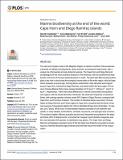Por favor, use este identificador para citar o enlazar a este item:
http://hdl.handle.net/10261/159765COMPARTIR / EXPORTAR:
 SHARE
BASE SHARE
BASE
|
|
| Visualizar otros formatos: MARC | Dublin Core | RDF | ORE | MODS | METS | DIDL | DATACITE | |

| Título: | Marine biodiversity at the end of the world: Cape Horn and Diego Ramírez islands |
Autor: | Friedlander, Alan M.; Ballesteros, Enric CSIC ORCID ; Bell, Tom W.; Giddens, Jonathan; Henning, Brad; Hüne, Mathias; Muñoz, Alex; Salinas-de-León, Pelayo; Sala, Enric CSIC | Fecha de publicación: | 2018 | Editor: | Public Library of Science | Citación: | PLoS ONE 13(1): e0189930 | Resumen: | The vast and complex coast of the Magellan Region of extreme southern Chile possesses a diversity of habitats including fjords, deep channels, and extensive kelp forests, with a unique mix of temperate and sub-Antarctic species. The Cape Horn and Diego RamõÂrez archipelagos are the most southerly locations in the Americas, with the southernmost kelp forests, and some of the least explored places on earth. The giant kelp Macrocystis pyrifera plays a key role in structuring the ecological communities of the entire region, with the large brown seaweed Lessonia spp. forming dense understories. Kelp densities were highest around Cape Horn, followed by Diego RamõÂrez, and lowest within the fjord region of Francisco Coloane Marine Park (mean canopy densities of 2.51 kg m-2, 2.29 kg m-2, and 2.14 kg m-2, respectively). There were clear differences in marine communities among these sub-regions, with the lowest diversity in the fjords. We observed 18 species of nearshore fishes, with average species richness nearly 50% higher at Diego RamõÂrez compared with Cape Horn and Francisco Coloane. The number of individual fishes was nearly 10 times higher at Diego RamõÂrez and 4 times higher at Cape Horn compared with the fjords. Dropcam surveys of mesophotic depths (53±105 m) identified 30 taxa from 25 families, 15 classes, and 7 phyla. While much of these deeper habitats consisted of soft sediment and cobble, in rocky habitats, echinoderms, mollusks, bryozoans, and sponges were common. The southern hagfish (Myxine australis) was the most frequently encountered of the deepsea fishes (50% of deployments), and while the Fueguian sprat (Sprattus fuegensis) was the most abundant fish species, its distribution was patchy. The Cape Horn and Diego RamõÂrez archipelagos represent some of the last intact sub-Antarctic ecosystems remaining and a recently declared large protected area will help ensure the health of this unique region. | Descripción: | Este artículo contiene 25 páginas, 6 tablas, 6 figuras, 2 anexos. | Versión del editor: | https://doi.org/10.1371/journal.pone.0189930 | URI: | http://hdl.handle.net/10261/159765 | ISSN: | 1932-6203 | Referencias: | Alan M. Friedlander, Enric Ballesteros, Tom W. Bell, Jonatha Giddens, Brad Henning, Mathias Hüne, Alex Muñoz, Pelayo Salinas-De-León, Enric Sala (2018): Data from: Marine biodiversity at the end of the world: Cape Horn and Diego Ramírez islands [Dataset]; Dryad; Version 1; https://doi.org/10.5061/dryad.jf36b |
| Aparece en las colecciones: | (CEAB) Artículos |
Ficheros en este ítem:
| Fichero | Descripción | Tamaño | Formato | |
|---|---|---|---|---|
| 2018.Friedlander et al_PLoS ONE_Cape Horn.pdf | 6,4 MB | Adobe PDF |  Visualizar/Abrir |
CORE Recommender
Page view(s)
317
checked on 23-abr-2024
Download(s)
338
checked on 23-abr-2024
Google ScholarTM
Check
NOTA: Los ítems de Digital.CSIC están protegidos por copyright, con todos los derechos reservados, a menos que se indique lo contrario.
